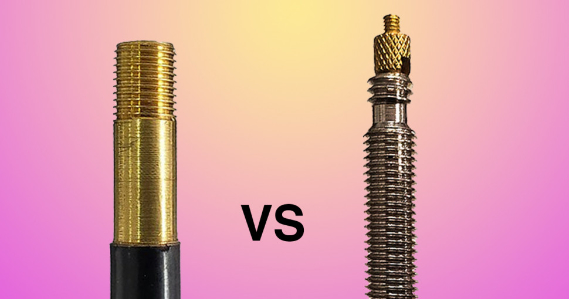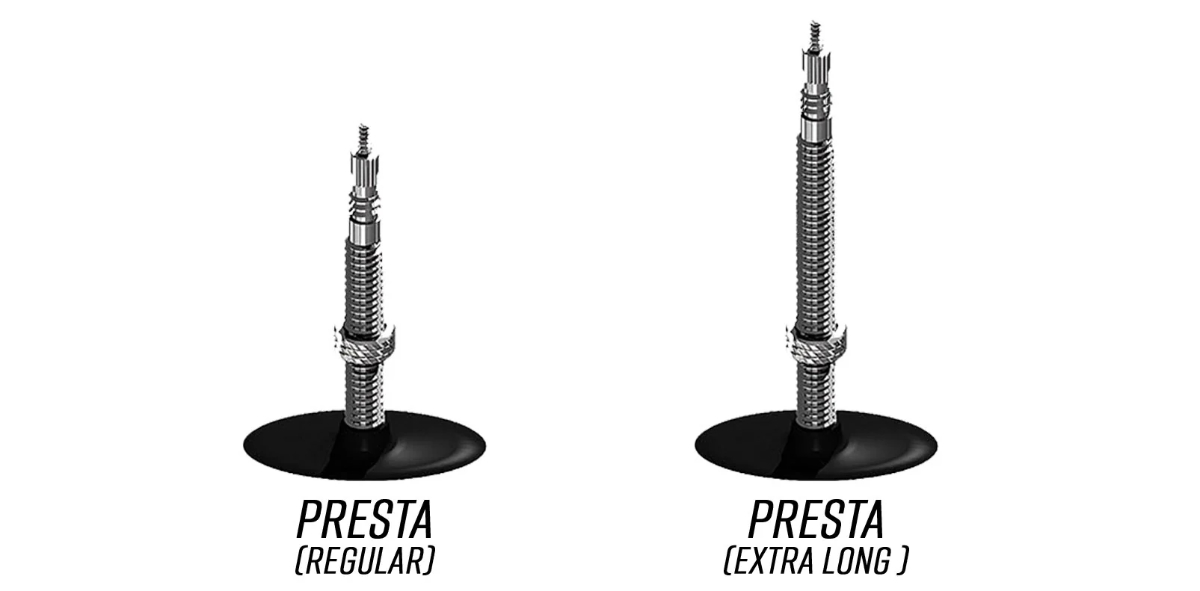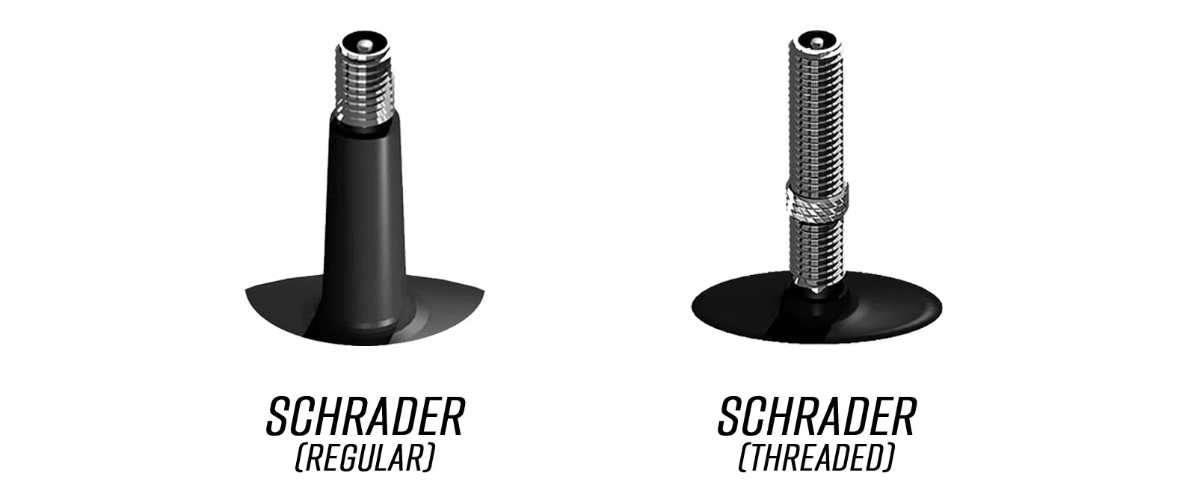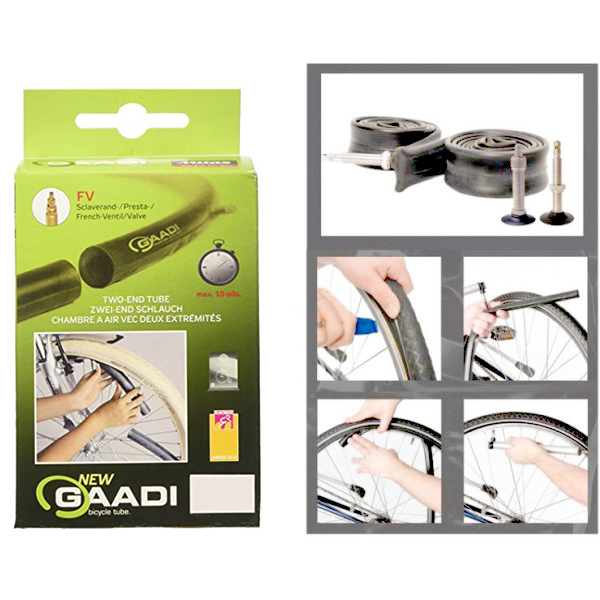Presta vs. Schrader Valve: What to Choose and How They Differ

Understanding the valves and types of inner tubes in bicycle tires is crucial because this knowledge can save you from ruining a promising day. If you don't know what type of valve your bike has, this post will help you figure it out and teach you how to take care of them.
Most bikes use either Schrader or Presta valves. If you see a valve similar to those used in car tires when inflating your bike tires, that's a Schrader valve. If you see a slim valve with a knurled end, that's a Presta valve.
Why do different bikes use different valve systems? How do they compare? Here’s everything you need to know about bicycle tire valves so you can ride without any issues.
Inner Tubes with Presta Valves
Presta valves, also known as French valves, are narrower and have a smaller diameter (6 mm) compared to Schrader valves. They are specifically designed for bicycles, especially those with narrow rims, as they require a smaller hole in the rim, reducing the risk of structural weakening. Presta valves can withstand higher air pressures, which is beneficial for road bikes where tire pressure often exceeds 125 psi.
One distinctive feature of the Presta valve is the lock nut that must be unscrewed before inflating the tire. Presta valves often have a removable core, making it easier to add sealant to tubeless tires.

Inner Tubes with Schrader Valves
Schrader valves, also known as car valves, are wider (8 mm) and more universal, often used in cars and cheaper bicycles. They have a simpler design with a spring-loaded mechanism that is easier to use when inflating at gas stations. However, due to their larger diameter, they require a larger hole in the rim, which can weaken narrow rims used in road bikes.

Inner Tubes with Dunlop Valves
During travels in Europe or Asia, you may encounter a third type of valve known as the Dunlop valve (or Woods valve). It resembles a thicker Presta valve and is often used in city bicycles.

Choosing the Right Inner Tube - Presta or Schrader?
The choice between Presta and Schrader valves depends primarily on the type of bike and rim specifications. Presta valves are a better choice for road and high-performance bikes because they are lighter, can withstand higher pressures, and require a smaller rim hole. Schrader valves are more practical and easier to use, especially for mountain and recreational bikes, as they can be inflated at standard gas stations and are more resistant to damage.
Here is a comparison of both types:
Presta Valves:
- Better choice for road and high-performance bikes.
- Lighter and can withstand higher air pressures.
- Require a smaller rim hole, reducing the risk of structural weakening.
- Require unscrewing the nut before inflating.
Schrader Valves:
- More practical and easier to use, especially for mountain and recreational bikes.
- Can be inflated at standard gas stations.
- More resistant to damage due to their construction.
The choice between these two valve types depends on user preference and the type of bike they are used on.
How to Inflate Tires with Presta and Schrader Valves
Inflating tires with Presta valves requires unscrewing a small nut on the valve before starting to pump, whereas with Schrader valves, you simply attach the pump head to the valve and pump. In both cases, it is recommended to carry an adapter, which allows the use of any pump with Presta or Schrader valves.
New Valve Types
As the width of bicycle rims increases and carbon rims become standard for higher-end bikes, new valve types are emerging that allow for fast airflow and do not clog with sealant like Presta valves can. An example of such a design is the Fillmore valves by Reserve, specifically designed for tubeless tires.
Valve Placement on Bikes
Both Schrader and Presta valves are located on the tires, protruding towards the hub inside the rim. Schrader valves can also be found in suspension systems (rear shocks and forks) and in adjustable seatposts. In the case of seatposts, the Schrader valve is typically hidden inside the seatpost itself.
Why Do Bikes Use Presta Valves?
Presta valves were invented by the same person who founded Zéfal, a leading manufacturer of bicycle pumps. Compared to Schrader valves, Presta valves are better suited for bicycle wheels for several reasons:
They require a smaller hole in the rim, increasing its strength.
They are lighter, reducing the need for additional balancing of high-performance wheels.
They seal themselves under air pressure, eliminating the need for a mechanical check valve as seen in Schrader systems (which can clog with contaminants).
They are easy to extend with adapters, making them ideal for deeper-section aerodynamic rims.
Can Presta and Schrader Valves be Interchanged?
You can install a Presta valve tube in a rim designed for Schrader valves, but it's not recommended for long-term use. Tubes and tires may shift slightly on the rim. In the wider Schrader hole, the Presta valve may move enough that the rim could cut the tube at the base of the valve. If you must install a Presta tube in a Schrader rim, use a valve nut to secure it close to the rim.
On the other hand, to install a Schrader tube in a rim designed for Presta valves, you would need to enlarge the valve hole, which could weaken the rim.
Valve Lengths
When installing a tube (or purchasing new ones), it's important to match the valve length to the depth of your bike's rims. Most Presta tubes come with valves ranging from 40-48 mm in length. However, for deep-section aerodynamic rims, sometimes valves of 80 or 100 mm are necessary.
Ensure that the spare tube you carry while riding has a valve long enough to fit your wheel. You can also use valve extenders to use shorter valves with deep-section rims. If using extenders, carry a valve core removal tool to install the extenders.
Which Pump to Use with These Valves?
Pumps designed specifically for Schrader valves have a pin inside the head that presses against the Schrader valve's check valve. Attempting to use it with a Presta valve will not be effective.
Pumps designed specifically for Presta valves have a rubber gasket in the head (or socket) that seals tightly against the Presta valve but does not fit onto a Schrader valve.
Fortunately, many bicycle pumps have dual-heads. These pumps come in three types:
- Dual Head: Found in some floor pumps, this head has separate seals for Presta and Schrader valves.
- Swappable Head: Found in some frame pumps and mini-pumps, this head has a conical seal — narrower side for Presta, wider side for Schrader. Simply unscrew the head cap, rotate the seal to the appropriate side, and screw it back on.
- Adjustable Head: The newest and most convenient type, this head fits both Presta and Schrader valves without needing to change any internal parts. Simply press the head firmly onto the valve, flip the lever to secure it, and begin pumping.
If you want to use a pump designed only for Schrader valves with Presta valves, you can purchase adapters at most bicycle shops. Also, note that some CO2 pumps are compatible only with Presta valves. Verify compatibility with your valve before installing the CO2 cartridge.
You cannot use a tire pump for front suspension, rear suspension, or adjustable seat posts. Suspension pumps (designed for adjusting air pressure in suspension components) do not work on tires. Tire pumps typically do not reach the high pressures required by suspensions. Suspension systems require precise pumps for accurate adjustments, which tire pumps usually do not have because they are designed for quickly inflating large volumes of air into tires. Additionally, suspension pumps are so small that inflating a Schrader valve tire would take forever.
Can I Replace Just the Valve?
Most valves are already attached to the tubes, so replacing them means replacing the entire tube. However, two scenarios may require valve replacement:
- Tubeless: Presta valves for tubeless tires have a threaded nut with a seal underneath that secures the valve to the rim. If the seal stops working and does not hold air, you can replace the valve. Some tubeless valves are specific to the wheel or rim model — make sure you purchase the correct replacement for a proper seal.
- Replaceable Cores: Some Presta valves have replaceable cores that can be unscrewed. These are needed for fitting valve extenders on aerodynamic rims or adding sealant to tires (which can clog the valve core if not removed first). If your tire does not hold air or the sealant clogs the core, you can simply replace the core with a new one. Most local bike shops sell replacement cores. You'll know your valve has replaceable cores if its sides have small, flat sections just before narrowing toward the top nut.

Recommended

CONTINENTAL MTB 29 Auto inner tube

CONTINENTAL MTB 27,5 Presta inner tube

CONTINENTAL MTB 29 Presta inner tube

CONTINENTAL MTB 26 Presta inner tube

CONTINENTAL MTB 27,5+ Auto inner tube

CONTINENTAL RACE 28 (700C) Wide Presta inner tube
